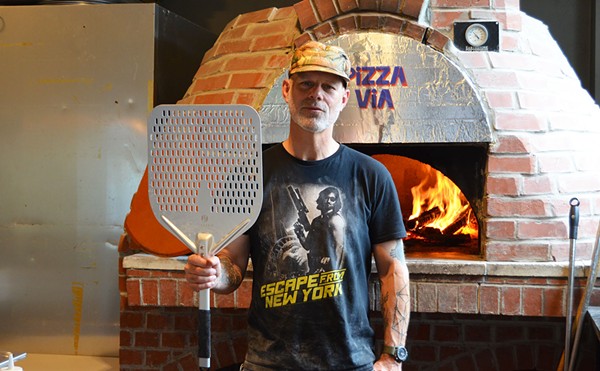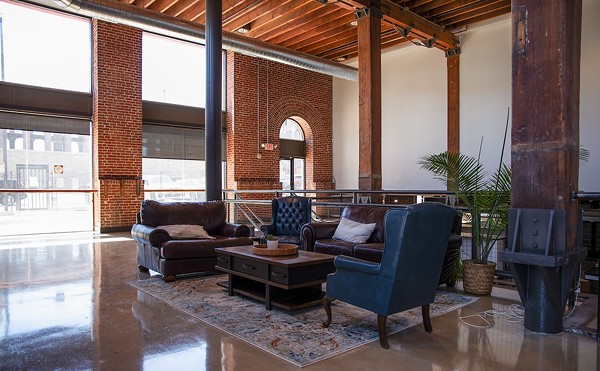But a number of my techniques are the generic ones published in countless paperback weight-loss tomes and get-slim-quick magazine articles: I don't clean my plate. I share desserts. I largely forgo alcohol and the bread basket, unless there's some nifty cocktail or artisan-style carbstravaganza that seems worth a try.
It takes a little luck, too. Specifically, I'm lucky that few restaurants dish out as many majestic platters of goodness as Aya Sofia does on a daily basis.
Two visits to Aya Sofia, a new Turkish/Mediterranean restaurant located in south St. Louis a stone's throw away from Ted Drewes' Chippewa outpost, rendered me distended. All my rules flew out the window; I couldn't help myself. I'd like to blame the cuisine — which is really all Turkish, right down to the Turkified spellings of some of the more generally Eurasian delicacies (the addition of the word Mediterranean on the front page of the menu seems to be there only to provide a familiar point of entry) — but as far as I know, Turks aren't known for being obese; we are. Besides, unfussy, salt-of-the-earth foodstuffs are what's at play here, with hardly a rich sauce or buttery bread to be seen. Instead the emphasis is on herbs, vegetables and legumes: beans and peas, cucumbers, spinach and tomatoes, rice, parsley, mint and dill. Cheese and yogurt show up quite a bit, and beef and lamb turn up as the staple proteins in a majority of entrées (with a grilled chicken breast and a New York strip thrown in for gastrophobes). But I can't fault any of those, because my waistband was crying uncle long before the main courses arrived.
I can and do blame Aya Sofia chef and proprietor Mehmet Yildiz for front-loading his relentlessly tempting bill of fare with an overabundance of appetizers — so much so that it's almost impossible to regard them as mere starters. On one visit five of us made an entire meal out of the menu's first page, which lists eight cold appetizers, seven hot appetizers and three appetizer platters, plus soups and salads. Though many of these overlap — some items can be served hot or cold, and the platters simply combine a number of the individual apps — it's hard to whittle down the choices to a respectable few.
Tabbouleh (here spelled tabuli) comes chock-full of diced tomatoes and onions, and a very fine grind of bulgur wheat, yet that trifecta serves as mere background to showcase the terrifically clean texture and green flavor of the chopped parsley. On the flip side, borek — a pie of feta cheese and spinach baked into phyllo, the Turkish cousin of spanakopita — was a more subtle pleasure, with the greens and cheese taking a back seat to the warm, cushy phyllo.
Sumac, the Middle Eastern spice derived from the bush of the same name and indigenous to the cuisine of Iran, Iraq and Turkey, isn't omnipresent at Aya Sofia. But it factors well into piyaz, a white bean salad made with parsley, tomatoes and onions and tossed with lemon and extra-virgin olive oil. Along with the onion, the sumac adds astringent zing to the dish, most notably when gobbled alongside the creamy hummus and the unique borulce, the latter a salad of black-eyed peas, parsley, bread crumbs and more lemon and olive oil. Without that tang, those preparations presented a strong starchiness that got to be a bit much.
With the exception of a swordfish steak, seafood appears only among the appetizers, in the form of ho-hum calamari — oversalted and too toasty — and skewers of firm grilled shrimp marinated in a terrific spice blend. Stuffed mussels have already been removed from the menu (they're crossed out in marker), but an additional seafood-based appetizer of the day usually fills in. On one visit that meant skewers of swordfish with a few rind-on lemon wedges thrown on the stick to intensify the fish's mild flavor.
At last, after this bounty of victuals — and oh yeah, the "bread basket": triangles of pillowy pita served with a heavenly dip of puréed roasted red bell peppers topped with grated Romano — come the entrées. In retrospect, I consider them to be mere rest stops between the first course and the last, a time to gather one's bearings while nibbling at some fine beef or lamb served over couscous or pilaf. The vertically grilled lamb and beef, similar to gyros and known here as iskender, was treated to a yogurt sauce and a tomato sauce; the latter, reminiscent of ketchup, hampered the dish and rendered it ordinary.
My favorite entrée is only available on the lunch menu: kofte, balls of grilled Turkish meat loaf the size of a child's fist, which at the server's suggestion I plunged liberally into a leftover appetizer plate of haydari, a lip-smackingly good yogurt dip.
There are only two desserts, but that's more than enough. The phyllo contained in the four tiny pieces of baklava seems there merely to lend the pastry some structure; this baklava is a fortress of pistachios and honey, which ooze out the sides when you pick up a piece. Rice pudding, simple and perfect, is served in a little porridge cup with a thick, mild pudding skin on top that makes the dessert come off almost like a crème brûlée.
To look at Aya Sofia from the outside, there's little indication that such abundance awaits within. It's a wooden box of a building, painted a drab gray, that used to house a toasted rav-slinging Italian joint. Yildiz has jazzed up the one-room dining space to the max — it could be photographed for the cover of the spring Pier 1 catalog. Curtained-off booths, their frameworks draped by swaths of glossy, fringed maroon fabric, run along two of the walls, which are painted a cream color on top but lined with a metallic-gold brickwork façade on the bottom. The ceiling fans' light fixtures are studded with stained-glass mosaic. Smartly, the tables themselves are outfitted in simple, stark white tablecloths with dark wooden chairs, preventing the look from spilling over into gypsy kitsch. Instead the décor ends up somewhere between the cartoonishness of Aladdin and the opulent elegance of the Topkapi Palace Museum.
Not only did I indulge in a couple of dessertinis (I just had to try them: They were mixed with Turkish coffee; served cold, they taste like any other mochatini, served hot, it's like drinking gasoline fumes), but I even went against my general rule to drink only calorie-free water or seltzer. Ayran I consider to be the Marmite of Turkish culinary curios: You might have to be a native to appreciate a plain yogurt smoothie dashed with table salt. I still can't say whether I enjoyed it, but I did find myself sipping it throughout the meal. I practically guzzled the meyva suyu, a fruit drink of peach tea and sour cherry and apple juices.
Wear elastic-waist pants when you go.





